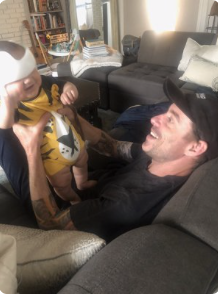The Day-to-Day
October 01, 2019
I have about a dozen different pieces of writing that are just about ready to post, but honestly, we have been too busy with reality—the reality of two working parents, of an exclusively pumping mama, of the emotional roller coaster that comes with the unexpected, and of course, of having an eight-month-old that requires therapeutic interventions daily. With this in mind, I thought I would share some insight into our day-to-day reality.
When we found out about Santiago’s condition, we took action immediately related to services for him. On the education front, Santiago works with a vision impairment teacher (TVI) and an orientation and mobility instructor (O&M). The former will be responsible for teaching him Braille; the latter tasked with helping him navigate the world and his surroundings with a cane. Ms. Pam and Ms. Tricia are awesome. Given Santiago’s young age, there is overlap with many of the interventions. Consequently, these two women come to the house and do collaborative sessions, which we love. We work on everything, including core strength for pre-crawling, vestibular sense / system development by moving on the peanut ball side-to-side, and tactile exposure by playing with whip cream, other food and even water beads. (You try sticking your hand in a bucket of water beads. It feels weird!) This type of sensory work reduces tactile sensitivity that often blind children experience. He is doing great in this area with the exception of solid food in his mouth. That will be a process (and another blog post).
In addition to VI and O&M, an occupational therapist (OT), physical therapist (PT), and speech therapist (ST) also service our little tiger twice weekly each for a total of six times a week. Now, this sometimes feels like overkill (because it totally is). Our house has a revolving door, and it is difficult to coordinate my work schedule given that I (or Cesar when possible) participate in every session. Part of our job is to learn from the experts and implement what they teach. So, why is so much therapy needed? Well, blind babies usually experience global development delays, specifically related to motor-skills. Sighted kids develop due to implicit learning; they don’t have to work for it. When on their tummy, sighted babies see something beyond their body and reach for it, which triggers them to move limbs, and ultimately crawl, stand, and walk. What is the motivation for Santiago?
This is a sampling of Santi's "work-out" activities. Song Source: “Eye of the Tiger” by Survivor (Lyricist: Survivor; Composers: Jim Peterik and Frankie Sullivan).
Nearly everyone thinks (and frequently suggests) why don’t just put a toy that makes noise across the room and he will want to go to that. It is not that simple. First and foremost, he gets the benefit of that toy sitting right where he is because guess what? He can still hear the toy without moving! This also applies when we try to use noises or noise-making toys to get him to “look up.” He can still hear the toy, the voice, the kissy sound, the clapping, or the singing with his head down and certainly without attempting to crawl. Sound localization takes time for sighted and blind alike. For Santiago, we have to connect that the noise is linked to something that he might want, which is a process. He is learning this concept on inanimate objects that are important to him (pacifier) and people that are close to him (Dad and Mom). I hear Mama’s voice. Therefore, Mama is here. And now, I smile because Mama is here and will likely pick me up. Wahoo! I am super excited that Mama is here so I reach up or “look” up and giggle uncontrollably.
Right now, we are encouraging him to explore outside his space, and he is learning! It is so cool to watch your child learn, especially when you don’t even know it is happening. He finds the pacifier in his crib—his favorite toy and prized possession—and puts it back in his mouth. He reaches for milk and the spoon when in the high chair. He looks for Dad and Mom. He anticipates movement and action based on words, which has been a recent development and pretty awesome to watch because it doesn’t happen with sighted babies this young. He is taking in the world around him—methodically and relatively patiently.
All in all, we celebrate the small victories, pray about the unknown, and remain grateful that we, as zebras, get to parent this tiger.
















